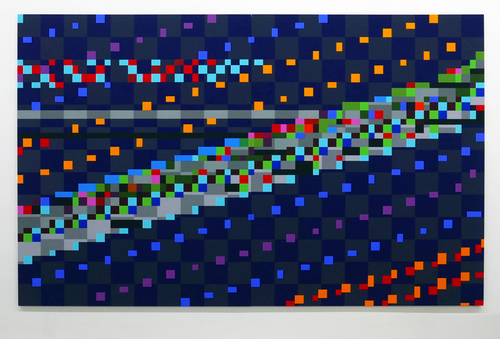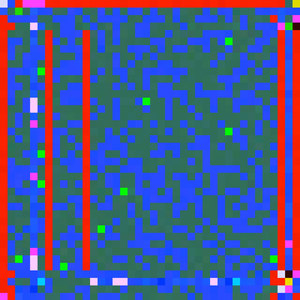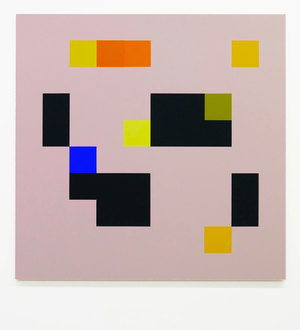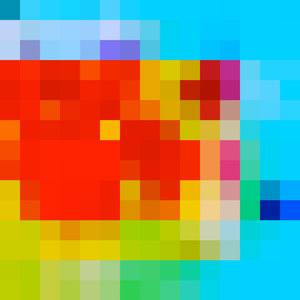 "solo exhibition"
"solo exhibition"Robert Owen
ARC ONE GALLERY
45 FLINDERS LANE MELBOURNE VIC 3000 AUSTRALIA
TELEPHONE +61 3 9650 0589 FAX +61 3 9650 0591 email
26 July > 27 August 2016
 Blue Note #2 2016 Synthetic polymer paint on canvas (two panels) 200 x 320 cm |
 Jazz Junction #16/3 2014-2016 Inkjet print on 310gsm 80 x 80 cm |
 Blue arose and fell (for Ulay) 2014-2016 Synthetic polymer paint on canvas 122 x 122 cm |
 Inside the Crystal #20 2014-2016 Inkjet print on 310gsm 80 x 80 cm |
ARC ONE Gallery is delighted to present the latest exhibition by leading senior Australian artist, Robert
Owen. In this self-titled solo show, Robert Owen presents a continuation of his celebrated
Music for the Eyes
and
Text of Light
series, with a new body of paintings and prints inspired by jazz, movement and light.
Employing a staccato-like language of abstraction and geometry, Owen’s vivid Jazz Junction (2014-16) paint - ings explore the relationship between 1950s jazz and optical arrangements of form and colour. His canvases translate musical elements of time, rhythm and pitch through an idiosyncratic and intuitive exploration of the colours and patterns in sound. While long-standing influences of Constructivism and the colour theories of Wassily Kandinsky remain, here Owen has also drawn on modernist painter Piet Mondrian – in particular, his famous New York City- and jazz-inspired Broadway Boogie Woogie (1942-43). With Owen’s resulting Blues for Mondrian series, bold gridlines frame vibrant pixels of colour that bounce on the canvas like fingers on the keys of a piano.
A set of large prints titled Inside the Crystal extends the artist’s continuous exploration of light and art’s capacity to capture mood and emotion through pigment. In these images colours across the spectrum refract and intersect, as along the edge of cut glass.
Owen’s visually-arresting works synthesise the cerebral with the emotional and sight with sound, highlighting how we perceive as humans through interrelated senses, also known as synaesthesia. This nexus of intellect and spirituality – or physical and metaphysical – is at the core of Owen’s practice, which for more than five decades has consistently sought to reconcile the fundamental human conditions of thinking and feeling.
Robert Owen is an internationally recognised and award-winning artist, with a practice that includes sculpture, installation, painting and photography. He has received widespread acclaim for his work on major public commissions such as Webb Bridge, Docklands (in collaboration with Denton Corker Marshall), and the Craigieburn Bypass, Melbourne (in collaboration with Architects Taylor Cullity Lethlean and Tonkin Zulaikha Greer). He represented Australia at the 38th Venice Biennale in 1978, and in 2003 he received the Australia Council Visual Arts/ Crafts Emeritus Award for a lifelong service to the visual arts. He is represented in public and private collections throughout Australia and internationally
Employing a staccato-like language of abstraction and geometry, Owen’s vivid Jazz Junction (2014-16) paint - ings explore the relationship between 1950s jazz and optical arrangements of form and colour. His canvases translate musical elements of time, rhythm and pitch through an idiosyncratic and intuitive exploration of the colours and patterns in sound. While long-standing influences of Constructivism and the colour theories of Wassily Kandinsky remain, here Owen has also drawn on modernist painter Piet Mondrian – in particular, his famous New York City- and jazz-inspired Broadway Boogie Woogie (1942-43). With Owen’s resulting Blues for Mondrian series, bold gridlines frame vibrant pixels of colour that bounce on the canvas like fingers on the keys of a piano.
A set of large prints titled Inside the Crystal extends the artist’s continuous exploration of light and art’s capacity to capture mood and emotion through pigment. In these images colours across the spectrum refract and intersect, as along the edge of cut glass.
Owen’s visually-arresting works synthesise the cerebral with the emotional and sight with sound, highlighting how we perceive as humans through interrelated senses, also known as synaesthesia. This nexus of intellect and spirituality – or physical and metaphysical – is at the core of Owen’s practice, which for more than five decades has consistently sought to reconcile the fundamental human conditions of thinking and feeling.
Robert Owen is an internationally recognised and award-winning artist, with a practice that includes sculpture, installation, painting and photography. He has received widespread acclaim for his work on major public commissions such as Webb Bridge, Docklands (in collaboration with Denton Corker Marshall), and the Craigieburn Bypass, Melbourne (in collaboration with Architects Taylor Cullity Lethlean and Tonkin Zulaikha Greer). He represented Australia at the 38th Venice Biennale in 1978, and in 2003 he received the Australia Council Visual Arts/ Crafts Emeritus Award for a lifelong service to the visual arts. He is represented in public and private collections throughout Australia and internationally









